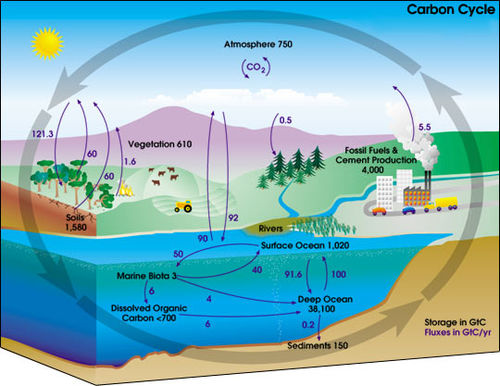
Oceans and coastal areas play an important role in regulation of the carbon cycle, as they serve as sinks for atmospheric carbon dioxide CO2. Carbon dioxide gas readily dissolves in water, although global increase of average ocean surface temperature releases increasing levels of carbon back into the atmosphere, as warm water has a decreased capacity to absorb gasses. As ilustrated in the figure above, producers such as macro algae canopies, microalgae and cyanobacteria take up dissolved carbon dioxide and by photosynthesis convert it into carbohydrates. This organic carbon is converted back into carbon dioxide or other substances as it is reused and repurposed in the food chain (Miller, 2002; Little et al., 2010).
In marine ecosystems, some organisms can take up dissolved molecules of inorganic carbon compounds and bind them with calcium ions (Ca2+) in order to create compounds such as calcium carbonate (CaCO3), that are used in creation of their shells and skeletons. As these organisms die, their shells serve as substrate for other organisms or sink to the sea floor, where, under extreme pressure, they turn into limestone rocks over the course of millions of years (Miller, 2002).
- The Biology of Rocky Shores. 2nd Edition, Little, Colin, Williams, Gray A. and Trowbridge, Cynthia D., 28 april 2010.
- Living in the Environment. 13th Edition, Miller, G. Tyler Jr., 2002.
- Carbon cycle diagram, Saff, Kevin, 2004.
Zie ook
- Dimensioning of a calcium reactor in a biofilter for restitution of calcium concentrations in shellfish
- Impact of cable bacteria on the biogeochemical cycling in a seasonal hypoxic basin
- Oyster reefs and coastal protection
- Climate Change 2021, the physical science basis, summary for policymakers
- The effects of biogeochemical stressors on seagrass ecosystems
- Toxicity of reduced nitrogen in eelgrass (Zostera marina) is highly dependent on shoot density and pH
- Ecosystem recovery after hypoxia: what can foraminifera indicate?
- Deltakennis Modelling Carrying Capacity
- Rock type
- Understanding seagrass resilience in temperate systems: the importance of timing of the disturbance






